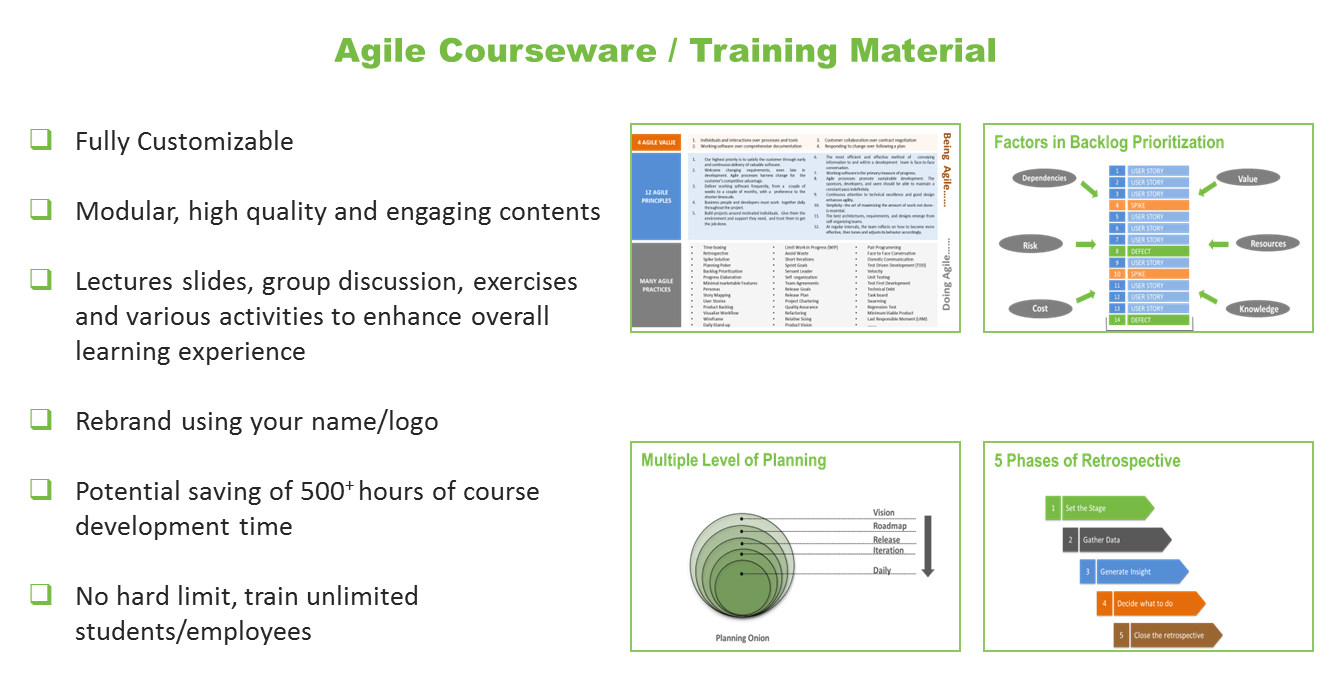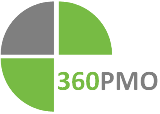PMI-ACP Courseware
Fully customizable PMI-ACP Courseware / Training material, design for trainers, consultants, education providers, and any organization willing to offer PMI-ACP training.
Why Choose Our Courseware /Training Material?
-
- Classroom tested high quality and engaging contents
-
- Offer comprehensive Agile training in no time
-
- The modular approach allows you to pick and choose slides and quickly develop contents appropriate to target audience
-
- Comprehensive modules; cover complete topic without breaking the sequence
-
- Interactive Agile games/exercises that allow your students gain basic concepts behind the individual topic
-
- Potential saving of 500+ hours of course development time
-
- Rebrand using your name and logo (and yes remove ours!)
-
- Train unlimited users, there is no hard limit to the number of employees or students
Courseware License & Add-ons
Agile Courseware – Basic License
Named License to Individual Instructor / Consultant / Coach
Agile Courseware – Enterprise License
For Organizations /Training Institutes
Optional Add-on – Full-Length Practice Exam
120 questions for competency assessment (MS Word Format)
Optional Add-on – Train the Trainer
3 hours coaching/mentoring remote session
Need Quote? or have question Contact Us
If you are a PMI Chapter and looking to Launch PMI-ACP EXAM PREP TRAINING, we can help. Please drop us a note through our Contact Us page.
Sample Course Slides
| Module Name | Topics Covered | # of Slides |
|---|---|---|
| Agile Framework | What is Agile?, Agile definitions, being Agile vs. doing Agile, Agile values, principles & practices, project noise and methodology selection, why Agile, difference between traditional and Agile, Agile history, Influencers, value delivery, sample project status reporting, high-level agile process map and agile true/false | |
| Agile Methods | Agile method used, Agile umbrella, prescriptive vs. adaptive scale, Scrum, Scrum roles, Extreme programming (XP), Kanban, Lean, Lean principles, Feature driven development, FDD 5 steps process, and FDD roles | |
| Agile Teams | Operating model of agile teams, Agility and Stages of Learning (Shu-Hai-Ri), Tuckman's Stages of Group Development, The Dreyfus Model of Skill Acquisition, Five Levels of Conflict and Resolution, Team Contract / Working Agreement and Team Collaboration | |
| Agile Approach to Planning | Multiple levels of Agile planning, product vision, Agile chartering, product road-map, story mapping, release planning, iteration planning and Minimally Marketable Feature (MMF) | |
| Scrum | What is Scrum, Scrum origin, Scrum pillars, Scrum cycle summary, Scrum roles (Product Owner, Scrum Master and Development Team), Scrum ceremonies (Sprint planning, daily stand-up, review & retrospective), Scrum artifacts (Product Backlog, Sprint Backlog & Increment) | |
| Extreme Programming (XP) | What is Extreme Programming (XP), XP Lifecycle, XP goals, XP concepts, XP values, XP principles, XP primary practices and theory of constraints (TOC), mindfulness, spikes vs. Slack | |
| User Stories | What is User Story? User Story template, The 3 C’s (Card, Conversation, and Confirmation), attribute of good user stories, INVEST, difference between epic, stories and themes, acceptance criteria, acceptance tests, slicing the cake concept, user role, user personas, extreme characters, Agile modeling and wireframes | |
| Product Backlog | What is the product backlog, product backlog grooming, properties of a good backlog: DEEP, ordering the backlog, factors in backlog prioritization, definition of done (DoD) and definition of ready (DoR), Value-Based Prioritization ( ROI/NPV/IRR, Compliance, Customer valued prioritization, Minimum Viable Product (MVP), Minimum Marketable Features (MMF), Relative prioritization, MosCoW, Kano Analysis) | |
| Kanban | Time-box vs. flow based process, Kanban model, Kanban board with work In progress (WIP) limits, core principles of Kanban, Kanban attributes, and Scrum vs. Kanban, Classes of Service | |
| Agile Estimating | Estimation challenges , why do we estimate, accuracy vs. precision, The cone of uncertainty, relative sizing, absolute vs. relative sizing, Levels of estimates, Estimation scale – fibonacci sequence, wide band delphi technique, planning poker, affinity estimating | |
| Testing in Agile | How traditional testing practices evolved, traditional & Agile testing contrasted, From test last to test driven, effective testing on Agile projects, Agile testing flow, Test Driven Development (TDD), Acceptance Test Driven Development (ATDD), Exploratory testing, scripted vs. exploratory and key learnings | |
| Agile Metrics | Waterfall vs. Agile metrics, velocity, cycle time, burn-up charts, burn-down charts, Cumulative flow Diagram (CFD), and escape defects | |
| Risk Management | What is risk management, traditional risk management process, traditional risk management process, how Agile addresses core risks, managing risk via Product backlog, risk burn-down charts, risk based spikes and Key learnings | |
| Retrospective | Retrospective –What is it?, 5 phases of retrospective, the prime directives, sample retrospective activities, | |
| Other Key Practices | Osmotic communication, Value Stream Mapping (VSM). Information radiators, generalizing specialist, Adaptive Leadership, brainstorming techniques, effectiveness of different modes of communication, walking Skeleton and match the definitions | |
| Total Slides |
Need Quote? or have question Contact Us
